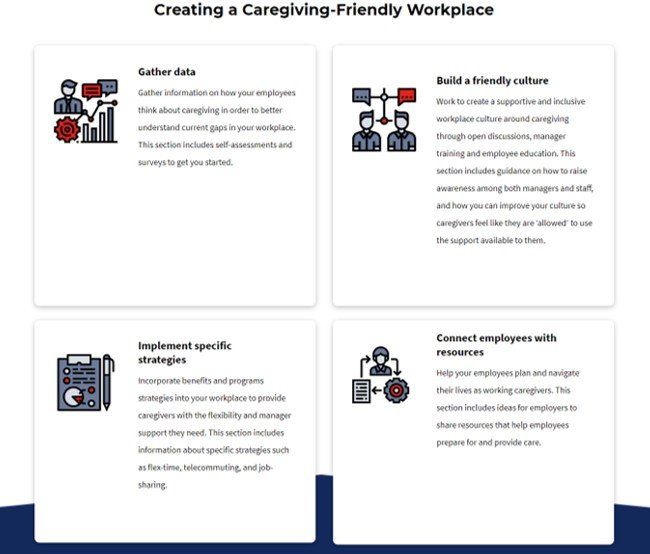AARP’s Tricia Sandiego Shares How Businesses Can Support Working Family Caregivers
I had a chance to speak to Tricia about America’s caregiving crisis and what small businesses, and women-owned businesses in particular, can do to build more supportive workplaces for themselves and their employees.
How important is it that every small business owner with employees addresses this issue right now to provide support to those juggling work with caregiving responsibilities?
Tricia: “Caregiving has always been a challenge in terms of balancing your work life and personal life, but I think COVID-19 has highlighted the challenges of working family caregivers.
Family caregivers are the backbone of our long-term health care system. They spend an average of 25 hours a week providing care on top of holding down their full-time or part-time jobs. It’s an important time for employers to tune into the needs that their working family caregivers may have. Some may have already been dealing with this juggle and struggle, but you may not have been aware of it as many caregivers do not self-identify or disclose their caregiving status with their employers.
In addition to knowing who your working family caregivers are, you need to communicate often about the value you place on caregiving and the strategies and programs you already have in place or will soon be offering. Ask your employees how you can collaborate and figure out solutions together. There is often no one-size fits all approach."
Have you seen any challenges that are unique to women business owners—and what advice would you offer them specifically?
Tricia: “Six out of 10 family caregivers are women. As women business owners, you may be balancing caregiving and work yourself, so think about what resources are available to you on the caregiving side. What things are you able to delegate to others? You may not have the time to do everything for your loved one, so see what you can split up among other family caregivers in the mix, like a sibling or spouse. Or look into hiring help or a service to take care of certain tasks. Also, look at community-based resources such as your local Area Agency on Aging. There may also be resources available to you through your health provider or health insurance, for instance.
For your role as business owner, think about what systems you can automate. Look for ways to get things done without you having to be the one who pushes the button all the time. Look at backfilling and cross training your staff to be able to do some of your responsibilities, but also to be able to fill in for each other if you or an employee need to take a leave of absence. You may not need it, but always have a backup plan in place because family caregiving is not always predictable and doesn’t have a timeline.”
What are some of the most innovative things you’ve seen businesses do to address this issue?
Tricia: “The current situation has really put a spotlight on the need to know how to leverage and maximize virtual technology for internal and external uses. Virtual programming was available previously but not utilized to its full potential. For example, the pandemic has forced people to be creative in terms of presentations, conferences and meetings, and technology has enabled this.
Also, people have become really creative with scheduling. Throughout the day, someone working from home while caregiving might have longer days logged in at work to make up for the time they take to provide care for a loved one during traditional work day hours. Or you may consider compressed work weeks, alternative schedules (i.e. working at night), or job sharing with a team member. As long as the work gets done, I think employers are increasingly embracing that creativity in scheduling.”
For those businesses that are proactive and get this right, what are the greatest benefits?
Tricia: “Think about supporting working family caregivers as a critical talent management strategy. Most employers say that their employees are their number one asset. Businesses that get this right will benefit in terms of recruitment, retention, productivity, and employee satisfaction. All this has impacts on your bottom line in terms of cost savings and return on investment. We’ve found that benefits like telecommuting and flexible work schedules can provide businesses ROI anywhere from $1.70- $4.45 for every dollar spent. As the U.S. population is aging, there will be more of a need for family caregivers to provide care. Businesses that plan for this by offering supports and flexibility to their staff will be ahead of the curve."
If small business owners knew one most critical thing about supporting their employees in this way, what would you want it to be?
Tricia: “There are easy ways you can support working family caregivers, and you may already have benefits in place. But it starts with communication and showing you have a culture of acceptance and care. There’s no one-size-fits-all solution for working family caregivers because everyone’s journey and caregiving experience is different and every employer is different. Communicate with your employees about what you are willing to offer in terms of flexibility, support and benefits, and create solutions together.
Be sure to offer resources for caregivers. AARP has free resources that employers can use and distribute to their employees. Employers can point them to aarp.org/caregiving and distribute anything ‘caregiving’ we have.”
WANTING MORE NEWS? SIGNUP TODAY
Contact Us









